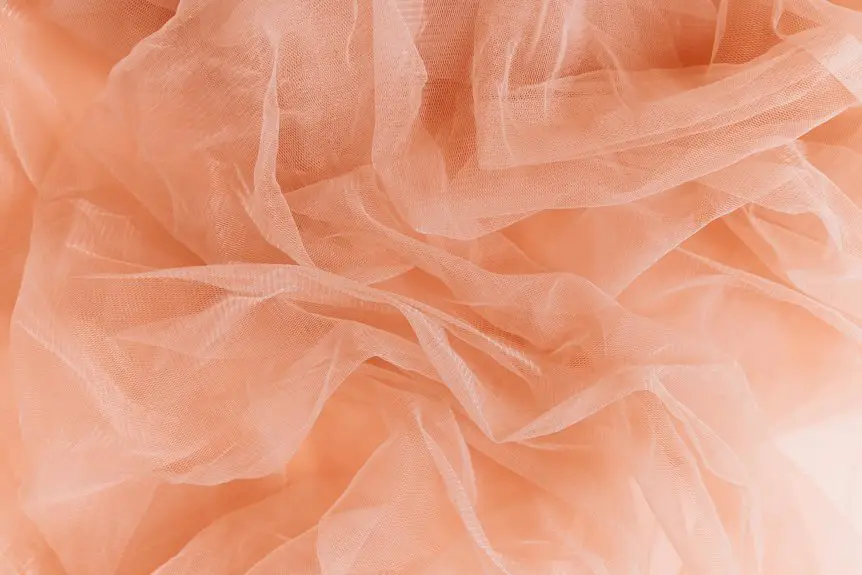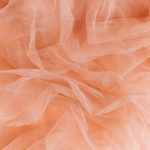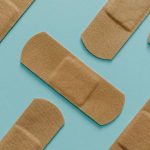If you’re looking for another name for gauze fabric, you might hear terms like cheesecloth, mull, or voile. Each shares gauze’s lightweight, breathable qualities but differs slightly in texture and use—cheesecloth suits culinary or medical needs, mull feels finer and smoother, and voile is softer and ideal for summer wear. Knowing these variations helps you pick the right fabric for your project. Keep exploring, and you’ll uncover even more textile insights and distinctions.
Table of Contents
Key Takeaways
- Gauze fabric is sometimes referred to as cheesecloth, especially in culinary and medical contexts.
- Mull is a finer, smoother cotton fabric similar to gauze but not identical.
- Voile shares gauze’s lightweight, sheer qualities but has a softer, smoother texture.
- Muslin is a tighter woven, more opaque fabric often compared to gauze for its cotton base.
- Gauze is distinguished by its loose, open weave and soft, breathable texture in textile terminology.
Historical Background of Gauze Fabric
Gauze fabric has been around for centuries, tracing its origins back to ancient civilizations like Egypt and Mesopotamia. You’d find that early artisans used loosely woven fibers to create lightweight cloths, perfect for bandages and clothing in hot climates.
As you explore history, you’ll see gauze evolving through the Middle Ages, spreading across Europe and Asia due to trade routes. When you handle gauze, you’re touching a textile that supported medical practices and everyday life long before modern manufacturing.
Over time, you’ll notice how the demand for breathable, sheer fabric kept gauze relevant, especially in healthcare. So, when you think about gauze, you’re connecting with a tradition of craftsmanship and utility that’s lasted thousands of years.
Characteristics Defining Gauze Material
When you examine this fabric closely, its defining traits become clear. Gauze is lightweight, sheer, and loosely woven, giving it breathability and a delicate texture. You’ll notice its open weave allows air and light to pass through easily, making it ideal for medical and fashion uses. Its softness guarantees comfort, while the flexibility lets it drape gracefully. Here’s a quick look at gauze’s key characteristics:
| Characteristic | Description |
|---|---|
| Weave | Loose, open |
| Texture | Soft, delicate |
| Transparency | Sheer, breathable |
| Flexibility | Lightweight, drapes well |
Understanding these traits helps you appreciate why gauze is versatile across different fields.
Cheesecloth as an Alternative Name
Although you might hear the term “cheesecloth” used interchangeably, it specifically refers to a type of gauze fabric known for its loose weave and breathability.
When you handle cheesecloth, you’ll notice its open, mesh-like structure, which makes it ideal for straining liquids or wrapping food.
You might associate cheesecloth mainly with culinary uses, but its lightweight and porous qualities also make it suitable for medical and crafting purposes.
If you’re shopping for gauze, knowing that cheesecloth falls under this category helps you select the right fabric for your needs.
Just keep in mind that while all cheesecloth can be considered gauze, not all gauze meets the specific weave and texture standards that define cheesecloth.
This distinction guarantees you pick the perfect fabric for your project.
Mull Fabric and Its Relation to Gauze
If you’ve become familiar with cheesecloth, you’ll find mull fabric shares some similarities but also stands apart in key ways.
Mull is a lightweight, plain-weave cotton fabric like gauze, but it’s usually finer and smoother. You’ll notice mull’s tighter weave gives it a softer hand and a slightly more polished look compared to gauze’s open, airy texture.
While both fabrics breathe well and drape nicely, mull often serves in garment linings, dresses, and curtains where a delicate finish is desired.
Gauze, on the other hand, leans more toward medical and culinary uses due to its loose weave.
Understanding mull’s relationship to gauze helps you choose the right fabric for your project, balancing texture, strength, and appearance effectively.
Voile: A Similar Lightweight Textile
You’ll notice that voile shares gauze’s lightweight and sheer qualities but feels smoother and softer to the touch.
It’s often used for curtains, summer clothing, and delicate linings where breathability matters.
Understanding voile helps you appreciate its versatility alongside gauze in various textile applications.
Voile Fabric Characteristics
Voile fabric offers a delicate, lightweight alternative to gauze, often chosen for its soft texture and subtle sheerness.
When you touch voile, you’ll notice its smooth finish and fine weave, making it feel gentle against your skin. Unlike gauze, voile has a tighter weave, which gives it a slightly more opaque appearance while still allowing light to pass through.
You’ll find that voile drapes beautifully, making it ideal for garments or curtains where flow and elegance matter.
It’s typically made from cotton or cotton blends, but you can also find silk or synthetic versions.
Because of its breathable nature, voile keeps you comfortable in warmer weather without sacrificing style or softness.
Uses of Voile
When choosing lightweight fabrics, consider how voile’s soft texture and graceful drape enhance various projects.
You’ll find voile perfect for summer clothing like blouses, dresses, and scarves because it’s breathable and comfortable against your skin. It’s also ideal for layering, adding a delicate, airy feel without bulk.
Beyond fashion, voile suits home décor tasks such as sheer curtains or light drapes, filtering sunlight while maintaining privacy. You can even use voile in crafting, creating lightweight linings or decorative wraps.
Since it’s easy to dye and print on, you can personalize your projects with vibrant patterns.
Whether you’re sewing garments or designing interiors, voile offers versatility and elegance, making it a smart choice for many creative applications.
Organza Compared to Gauze Fabric
Although both organza and gauze fabrics share a lightweight and sheer quality, they serve different purposes and offer distinct textures.
When you handle organza, you’ll notice its crisp, stiff feel that holds shape well, making it ideal for structured garments like evening gowns or decorative overlays.
Gauze, on the other hand, feels soft and loosely woven, giving it a breathable, flowing drape perfect for casual wear or medical uses.
Organza’s smooth, shiny surface contrasts with gauze’s matte, open-weave appearance.
Organza offers a smooth, shiny finish, while gauze showcases a matte, open-weave texture.
If you want fabric with firmness and elegance, organza fits the bill.
But if softness and airiness matter more, gauze is your go-to.
Understanding these differences helps you choose the right fabric for your project’s needs without confusion.
Uses of Gauze Under Different Names
Since gauze fabric appears under various names, you might not always recognize its versatile uses at first glance. Whether called cheesecloth, marquisette, or scrim, gauze adapts to many needs. You’ll find it in medical settings, fashion, and even home décor. Its lightweight, breathable nature makes it perfect for bandages and curtains alike.
| Name | Common Use |
|---|---|
| Cheesecloth | Straining, food wrapping |
| Marquisette | Sheer clothing, veils |
| Scrim | Theater backdrops, lining |
Regional Names for Gauze Fabric
Regional names for gauze fabric vary widely, reflecting local culture and language. When you explore different regions, you’ll find unique terms that highlight gauze’s versatility:
- Chiffon (France) – Lightweight and sheer, often used in fashion.
- Gasa (Spain) – Commonly used for medical bandages and dressmaking.
- Cheesecloth (United States) – A loosely woven cotton fabric used in cooking and crafts.
- Jinnee (India) – A fine, airy cotton fabric popular in traditional garments.
Knowing these names helps you appreciate gauze’s global significance and guides you in sourcing the right fabric.
Each term carries local nuances, so when you shop or study textiles, recognizing these regional labels can make a big difference.
Differences Between Gauze and Muslin
When you compare gauze and muslin, you’ll notice that both fabrics serve different purposes despite their similar lightweight nature.
Gauze typically features an open, loose weave that makes it breathable and slightly sheer. You’ll find gauze used in medical dressings, baby swaddles, or lightweight scarves due to its soft texture and airiness.
Muslin, on the other hand, has a tighter weave and feels smoother and more durable. You’ll often encounter muslin in dressmaking, quilting, or as a backdrop in photography because it holds shape better.
While both are cotton-based and versatile, gauze prioritizes breathability and softness, whereas muslin focuses on strength and versatility for crafting and apparel.
Understanding these differences helps you choose the right fabric for your specific needs.
Identifying Gauze in Modern Textile Markets
How can you quickly spot gauze fabric in today’s crowded textile markets? Start by focusing on its distinct characteristics.
First, look for a lightweight, loosely woven texture that feels airy and soft.
Second, check for visible open spaces between threads, giving it a mesh-like appearance.
Third, notice its slight transparency—gauze often lets light pass through easily.
Finally, examine the fabric’s flexibility; gauze drapes smoothly and tends to wrinkle less than similar textiles.
When you keep these points in mind, you’ll confidently identify gauze among other fabrics.
Frequently Asked Questions
How Is Gauze Fabric Produced in Sustainable Ways?
You create sustainable gauze fabric by using organic fibers, employing eco-friendly dyes, and adopting water-saving production methods. You can also support fair labor practices and choose biodegradable materials to reduce environmental impact throughout the process.
Can Gauze Fabric Be Dyed Without Losing Texture?
Dyeing gauze fabric without losing texture is like painting on a delicate canvas—you’ll want to use gentle dyes and low-temperature processes. You can maintain its light, airy feel by avoiding harsh chemicals and excessive agitation.
What Are Common Care Instructions for Gauze Textiles?
You should hand wash gauze textiles in cold water, avoid harsh detergents, and air dry them to keep their texture intact. Avoid wringing or using high heat, which can damage the delicate fibers.
Are There Synthetic Versions of Traditional Gauze?
Imagine a delicate spider’s web, both fragile and strong. You’ll find synthetic gauze versions mimicking that balance—made from polyester or nylon—they offer durability and easy care, perfect when you want gauze’s look without the fuss.
How Does Gauze Fabric Perform in Medical Applications?
You’ll find gauze fabric performs excellently in medical applications because it’s breathable, absorbent, and lightweight. It helps wounds heal by allowing air flow while soaking up fluids, reducing infection risk and promoting comfort.
- Does Chiffon Fabric Stink - July 15, 2025
- Does Chiffon Fabric Affect the Economy - July 15, 2025
- Does Cotton Fabric Have a Nap - July 15, 2025







